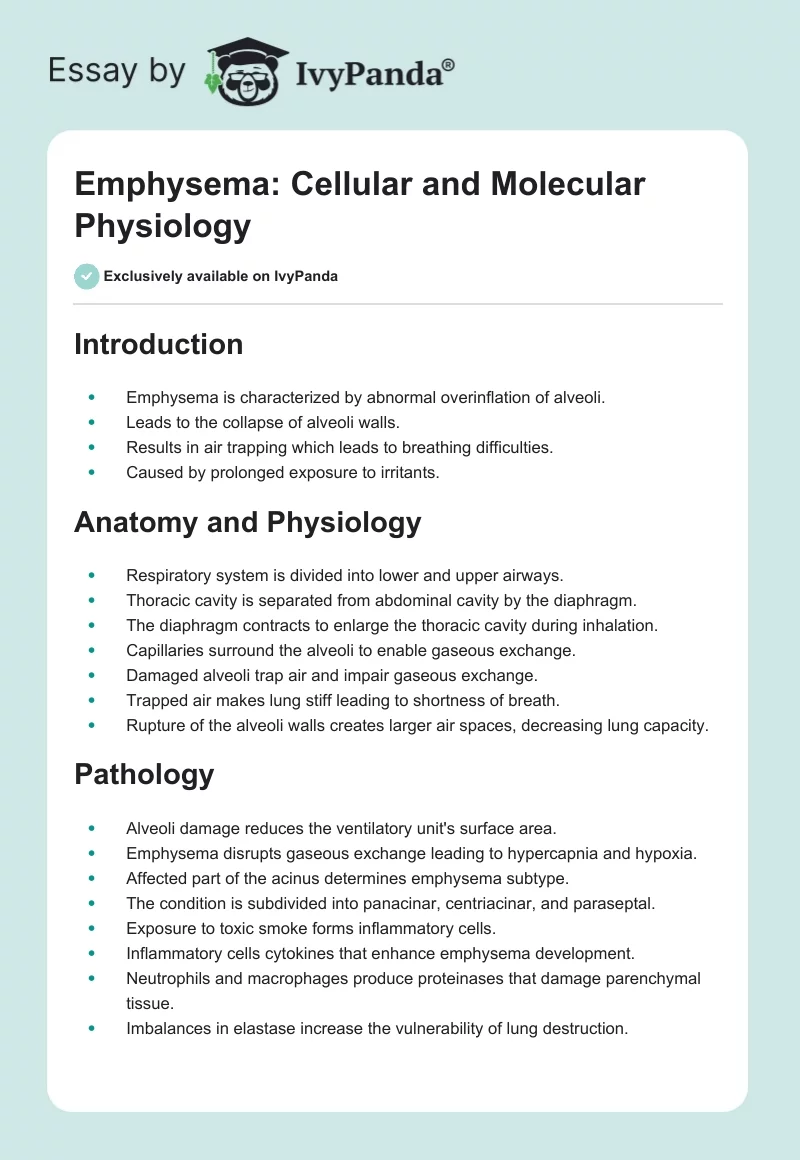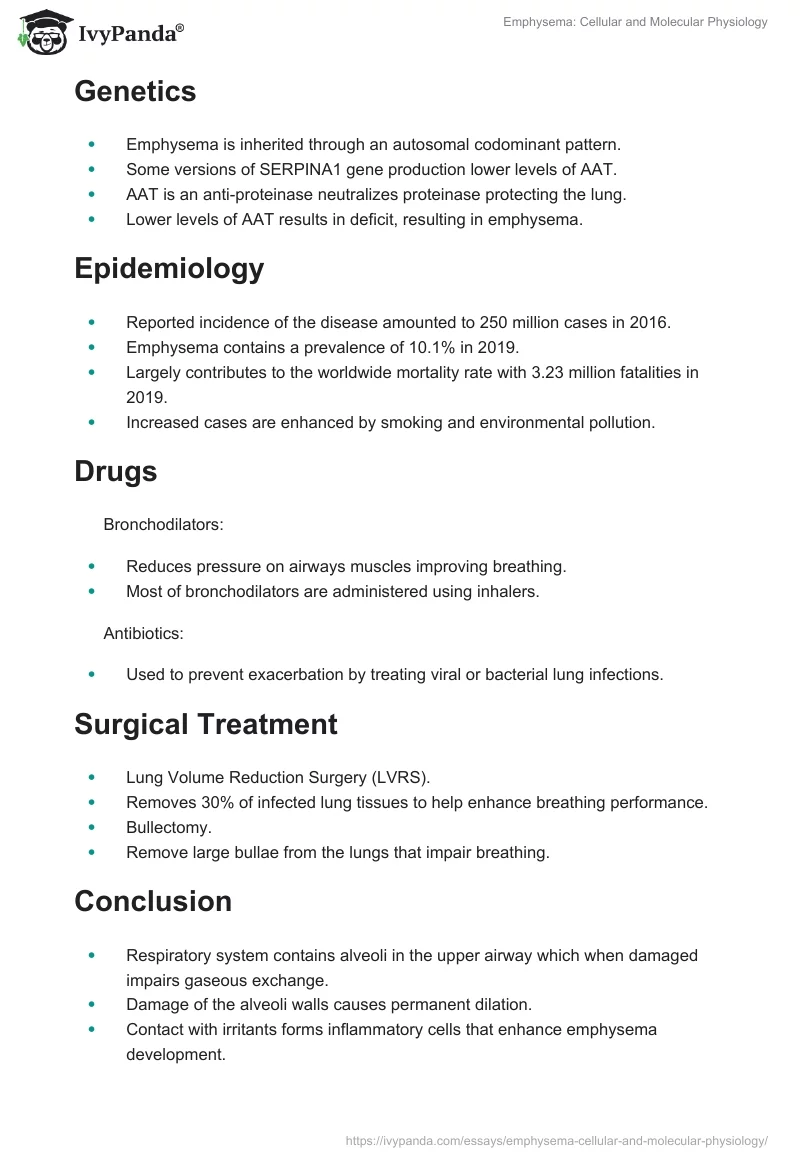Introduction
- Emphysema is characterized by abnormal overinflation of alveoli.
- Leads to the collapse of alveoli walls.
- Results in air trapping which leads to breathing difficulties.
- Caused by prolonged exposure to irritants.
Anatomy and Physiology
- Respiratory system is divided into lower and upper airways.
- Thoracic cavity is separated from abdominal cavity by the diaphragm.
- The diaphragm contracts to enlarge the thoracic cavity during inhalation.
- Capillaries surround the alveoli to enable gaseous exchange.
- Damaged alveoli trap air and impair gaseous exchange.
- Trapped air makes lung stiff leading to shortness of breath.
- Rupture of the alveoli walls creates larger air spaces, decreasing lung capacity.
Pathology
- Alveoli damage reduces the ventilatory unit’s surface area.
- Emphysema disrupts gaseous exchange leading to hypercapnia and hypoxia.
- Affected part of the acinus determines emphysema subtype.
- The condition is subdivided into panacinar, centriacinar, and paraseptal.
- Exposure to toxic smoke forms inflammatory cells.
- Inflammatory cells cytokines that enhance emphysema development.
- Neutrophils and macrophages produce proteinases that damage parenchymal tissue.
- Imbalances in elastase increase the vulnerability of lung destruction.
Genetics
- Emphysema is inherited through an autosomal codominant pattern.
- Some versions of SERPINA1 gene production lower levels of AAT.
- AAT is an anti-proteinase neutralizes proteinase protecting the lung.
- Lower levels of AAT results in deficit, resulting in emphysema.
Epidemiology
- Reported incidence of the disease amounted to 250 million cases in 2016.
- Emphysema contains a prevalence of 10.1% in 2019.
- Largely contributes to the worldwide mortality rate with 3.23 million fatalities in 2019.
- Increased cases are enhanced by smoking and environmental pollution.
Drugs
Bronchodilators:
- Reduces pressure on airways muscles improving breathing.
- Most of bronchodilators are administered using inhalers.
Antibiotics:
- Used to prevent exacerbation by treating viral or bacterial lung infections.
Surgical Treatment
- Lung Volume Reduction Surgery (LVRS).
- Removes 30% of infected lung tissues to help enhance breathing performance.
- Bullectomy.
- Remove large bullae from the lungs that impair breathing.
Conclusion
- Respiratory system contains alveoli in the upper airway which when damaged impairs gaseous exchange.
- Damage of the alveoli walls causes permanent dilation.
- Contact with irritants forms inflammatory cells that enhance emphysema development.
- COPD conditions contribute significantly to worldwide mortality rates.
- Can be caused with a genetic deficiency of AAT.
- Emphysema contains drug treatments like bronchodilators and antibiotics and surgeries such as LVRS and bullectomy.
References
Alpha -1 Antitrypsin Deficiency. St Vincent’s Lung Health. (2022). Web.
Boka, K. (2021). Emphysema. Medscape. Web.
Braber, S., Koelink, P., Henricks, P., Jackson, P., Nijkamp, F., Garssen, J., Kraneveld, A., Blalock, J., & Folkerts, G. (2011). Cigarette smoke-induced lung emphysema in mice is associated with prolyl endopeptidase, an enzyme involved in collagen breakdown. American Journal of Physiology-Lung Cellular and Molecular Physiology, 300(2), 1–210. Web.
Cattamanchi, A. (2020). Emphysema: Symptoms, stages, causes, treatments, and outlook. Medical News Today. Web.
Devasahayam, J., LaFreniere, K., & Naik, R. (2022). Chronic emphysema. StatPearls. Web.
Diamond, J., Evans, N., Haselhort, K., Kibbe, C., Kirsch, N., Laughton, F., Long, T., McDonald, M., Mathre, M., Nichols, M., O’Toole, J., Robertson, L., Sbriscia, T., Schmid, S., Wilson, S., & Zeman, S. (2022). Chronic obstructive pulmonary disease (COPD). ATrain Education. Web.
Geffen, W., Slebos, D.-J., Herth, F., Kemp, S., Weder, W., & Shah, P. (2019). Surgical and endoscopic interventions that reduce lung volume for emphysema: A systemic review and meta-analysis. The Lancet Respiratory Medicine, 7(4), 313–324. Web.
Hazari, Y., Bashir, A., Habib, M., Bashir, S., Habib, H., Qasim, A., Shah, N., Haq, E., Teckman, J., & Fazili, K. (2017). Alpha-1-antitrypsin deficiency: Genetic variations, clinical manifestations and therapeutic interventions. Mutation Research/Reviews in Mutation Research, 773, 14–25. Web.
Human respiratory system. Adobe Stock. (2022). Web.
Increased medication burden for patients with both asthma and allergies. Pulmonology Advisor. (2018). Web.
Jarhyan, P., Hutchinson, A., Khaw, D., Prabhakaran, D., & Mohan, S. (2022). Prevalence of chronic obstructive pulmonary disease and chronic bronchitis in eight countries: A systematic review and meta-analysis. Bulletin of the World Health Organization, 100(03), 216–230. Web.
Lin, H., Zhang, H., Yang, D., Chen, X., Chen, Y., Song, D., Cai, C., & Zeng, Y. (2022). Bronchoscopic treatment of giant emphysematous bullae with endobronchial silicone plugs. International Journal of Chronic Obstructive Pulmonary Disease, 17, 1743–1750. Web.
Lung volume reduction surgery for emphysema has durable benefits by American Association for thoracic surgerymedicalexpo. Medicalexpo. (2022). Web.
Mazzoni, V., Hampton, L., Abdullzaher, E., Jackson, K., WikiSysop, A., Thomas, E., Lee, M., & Chukwuemeka, U. (2022). Emphysema. Physiopedia. Web.
Pahal, P., Avula, A., & Sharma, S. (2022). Emphysema. Web.
Pulmonary emphysema. Johns Hopkins Medicine. (2019). Web.
Shockey, G. (2014). Alveoli. Fine Art America. Web.
The dangers of smoking, the lungs of a healthy person and smoker alveoli. 123RF. (2022). Web.
U.S. National Library of Medicine (NLM). (2021). Alpha-1 antitrypsin deficiency. MedlinePlus. Web.


